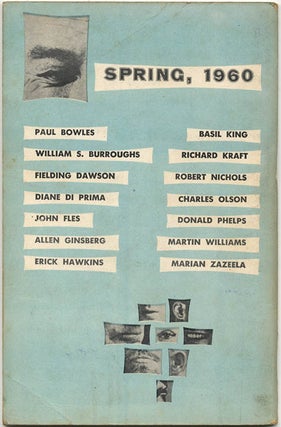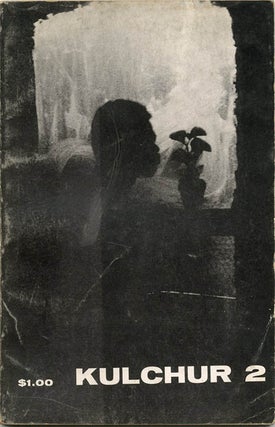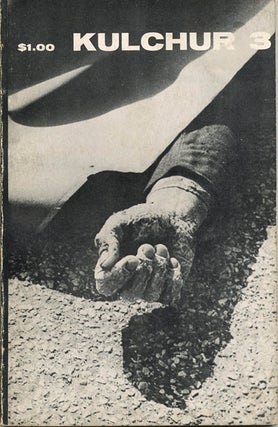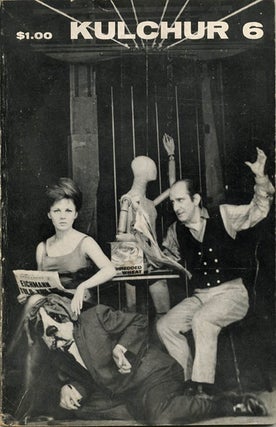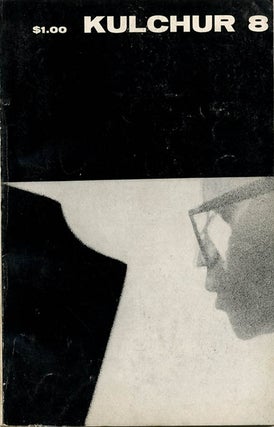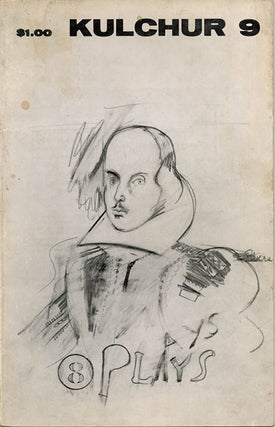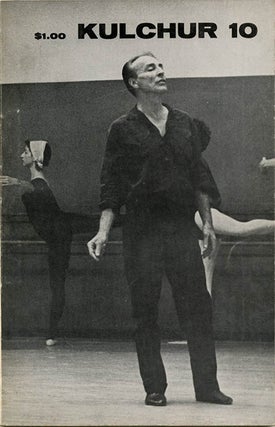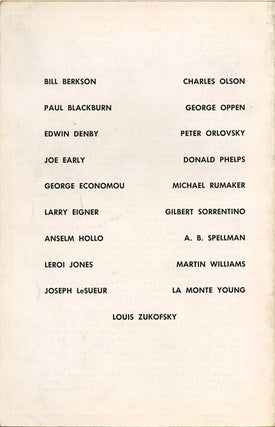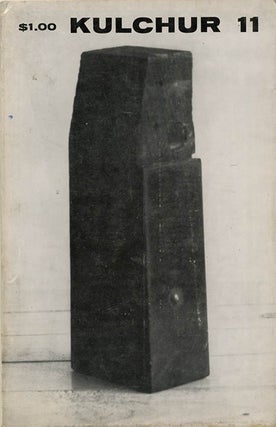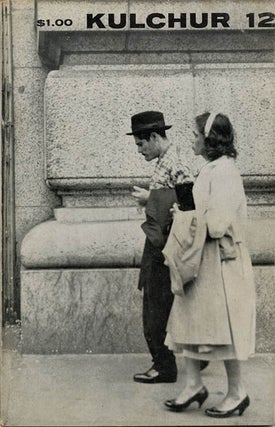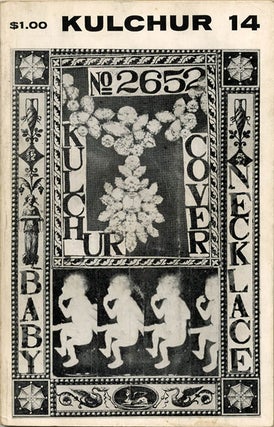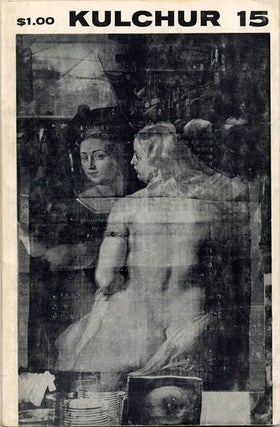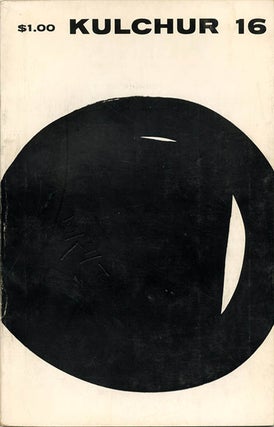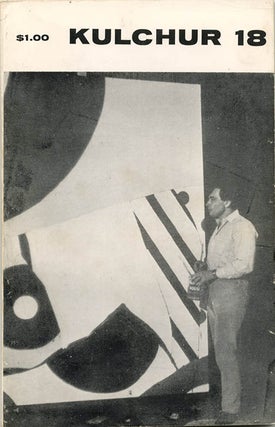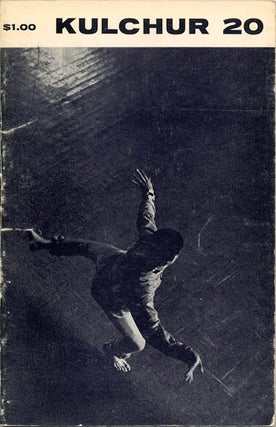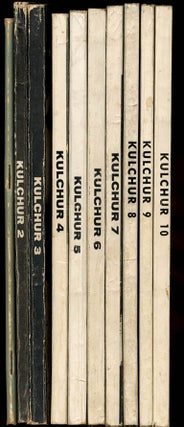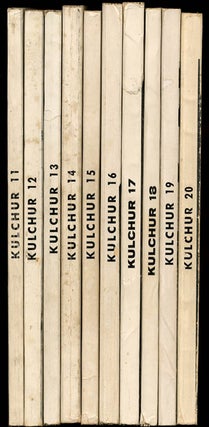63.
KULCHUR #1-20 (all published).
NY: Spring 1960-Winter 1965. 8vo. Wrps., 52pp.-104pp. First issue staple-bound, perfect bound from issue #2 on. Printed offset. Published and edited by Marc Schleifer (#1-3); Lita Hornick became the publisher from issue #3 and the editor from issue #6. Issues #4 and #5 were guest-edited by Gilbert Sorrentino and Joel Oppenheimer respectively. Contributing editors include John Fles, LeRoi Jones, Charles Olson, Diane di Prima, A.B. Spellman, Bill Berkson (film editor), and Frank O'Hara (art editor, issues #7-15).
The front covers feature work by Arthur Freed, Franz Kline, Larry Rivers, Kenneth Eisler, Joe Brainard, Robert Rauschenberg, Andy Warhol (+ a picture portfolio from his film “The Kiss” in #13 and Disaster series in #17), Al Held, Robert Indiana, and, for issue #4, a photograph of William Burroughs and Jack Kerouac in Paris c. 1955, provided by Marc Schleifer’s then wife, Marian Zazeela.
A full set of this important, influential and often contentious little magazine that focused on cultural criticism and covered a range of topics from avant-garde literature, film, jazz, architecture, dance, drama, poetry and painting to civil rights and politics.
Its many contributors include: William Burroughs (“The Conspiracy”, an excised section from “Naked Lunch”, and the first piece in the first issue; and “In Search of Yage” in the third issue); Allen Ginsberg; Paul Bowles; Charles Olson; Gregory Corso; Tuli Kupferberg; Herbert Huncke; Gary Snyder; George Brecht (‘sound scores’); ‘Harry Black’ (pseud. Hubert Selby Jr.); Ed Dorn (including “Notes More or Less Relevant to Burroughs and Trocchi”, 20pp., in #7); Louis Zukofsky (including the first appearance of his play, “Arise, Arise”, in #6); Julian Beck (+ picture portfolio on the Living Theatre); Jonathan Williams; Denise Levertov; Morton Feldman; Frank O’Hara (including three “Art Chronicles”); Robert Kelly; Gael Turnbull; Fielding Dawson; Michael McClure; Bill Berkson (including three “Film Chronicles”); La Monte Young (including “Excerpts from 'Lecture 1960' “ in #10); Robert Duncan (“Ideas on the Meaning of Form”); Richard Brautigan (“The Post Offices of Eastern Oregon” in #13); Robert Creeley; Nicolas Calas (on Robert Rauschenberg and others); Ron Padgett; Joe Brainard; Ted Berrigan; Carl Belz (on Warhol, Bruce Conner + illustrations in #17); Tom Veitch; and Donatella Manganotti (“The Final Fix”, 12pp., on William Burroughs, in issue #15).
Interviewees include Andy Warhol, Paul Goodman and Gerard Malanga, and the journal’s various reviewers include Gregory Corso, Paul Blackburn, Ed Dorn, Morton Feldman, Charles Olson, Marion Brown, Pauline Kael, Gerard Malanga, David Meltzer, Ted Berrigan, John Sinclair, Ron Padgett, Aram Saroyan, Thomas Clark, and the contributing editors.
Condition overall is Very Good or better (lower wrapper corner crease to #1; top corner bump to lower wrapper of #3; diagonal crease to upper right corner of front cover of #5; wrappers of some issues slightly rubbed).
Complete sets of what Gilbert Sorrentino has described as “one of the great magazines of the twentieth century… as important as The Little Review, The Dial, transition, The Criterion, and Contact” are extremely rare as some issues were produced in print runs of only 500 copies and quickly sold out.
 Back to top
Back to top



